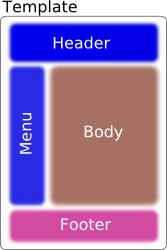Hatim has written a very nice blogpost about Roo and Spring Security, including source and going into a good level of detail.
I don’t know if you’ve noticed yet, but I’m a big fan of both Roo and the guys behind Roo. Big thanks to Alan & James from the forum post, ROO-1537 and ROO-1538, as of git version a474dc7b95613fae564f0e0fa50d89a6818bd753, and tested today one day later, my scripts run flawlessly through the tests! ![]() Which means, we can continue with Tiles. Stay tuned!
Which means, we can continue with Tiles. Stay tuned!
While resolving the test problems in the last code, let’s look at what we get by doing a
mvn jetty:run
The application has a header on top, a footer in the bottom, and a menu on the left hand side. This is in line with the Composite View pattern described in the Tiles tutorial: . To recompose this layout, see src/main/webapp/WEB-INF/layouts/layouts.jspx. In there you find that what we want to work with is
. To recompose this layout, see src/main/webapp/WEB-INF/layouts/layouts.jspx. In there you find that what we want to work with is
I love Roo! Ben Alex and his team have made a great job making starting a Spring project a breeze. However, I’ve shied away from using Java for XHTML/JS/CSS since 2003, so while I know the underlying technologies with Roo (JPA, the databases, Spring, JUnit, Tomcat, etc etc) I don’t know Apache Tiles at all. So I figured I’d like to learn it, at least until Roo 1.1 hits in a few weeks, when I’ll probably want to learn GWT. ![]() Stay tuned…
Stay tuned…
So, for learning this I’m going to make a project I’ve been planning ever since I released my awesome tuner for early music musicians: Well Tempered for the iPhone: Open Temperament. It’s going to be an open database for tuning temperaments. So, first step, register the domain (let’s hope this isn’t going to be one of those many great ideas that are parked on a domain due to lack of time ![]() ), done, and let’s get the basic Roo script up:
), done, and let’s get the basic Roo script up:
project -topLevelPackage net.opentemperament
persistence setup -provider OPENJPA -database HYPERSONIC_PERSISTENTentity -class ~.entities.Family -testAutomatically
field string -fieldName nameentity -class ~.entities.Temperament -testAutomatically
field string -fieldName title
field string -fieldName description
field string -fieldName originalAuthor
field reference -type ~entities.Family -fieldName familyentity -class ~.entities.OnlineUser
field string -fieldName fullname
field string -fieldName email
field reference -class ~.entities.Temperament -fieldName onlineAuthor -type ~.entities.OnlineUserentity -class ~.entities.Note -testAutomatically
field string -fieldName name
field reference -type ~.entities.Note -fieldName enharmonicTwin
field number -fieldName indexFromA -type java.lang.Integerfield reference -fieldName startingNote -type ~.entities.Note -class ~.entities.Temperament
entity -class ~.entities.Comma -testAutomatically
field string -fieldName name -notNull
field number -fieldName ratio -type java.lang.Double
field number -fieldName ratioInCents -type java.lang.Double
field reference -type ~.entities.Comma -fieldName aliasenum type -class ~.enums.IntervalType
enum constant -name MinorSecond
enum constant -name MajorSecond
enum constant -name MinorThird
enum constant -name MajorThird
enum constant -name PureFourth
enum constant -name PureFifthentity -class ~.entities.Deviation -testAutomatically
field reference -type ~.entities.Note -fieldName lowestNote -notNull
field enum -type ~.enums.IntervalType -fieldName intervalType -notNull
field reference -type ~.entities.Comma -fieldName deviationType -notNull
field number -fieldName deviationValue -type java.lang.Doublefield set -class ~.entities.Temperament -element ~.entities.Deviation -fieldName deviations
controller all -package ~.web
logging setup -level DEBUG
security setupjson add -class ~.entities.Family
json add -class ~.entities.Temperament
json add -class ~.entities.OnlineUser
json add -class ~.entities.Note
json add -class ~.entities.Comma
json add -class ~.entities.Deviationperform eclipse
perform test
Follow Me
Follow me online and join a conversation